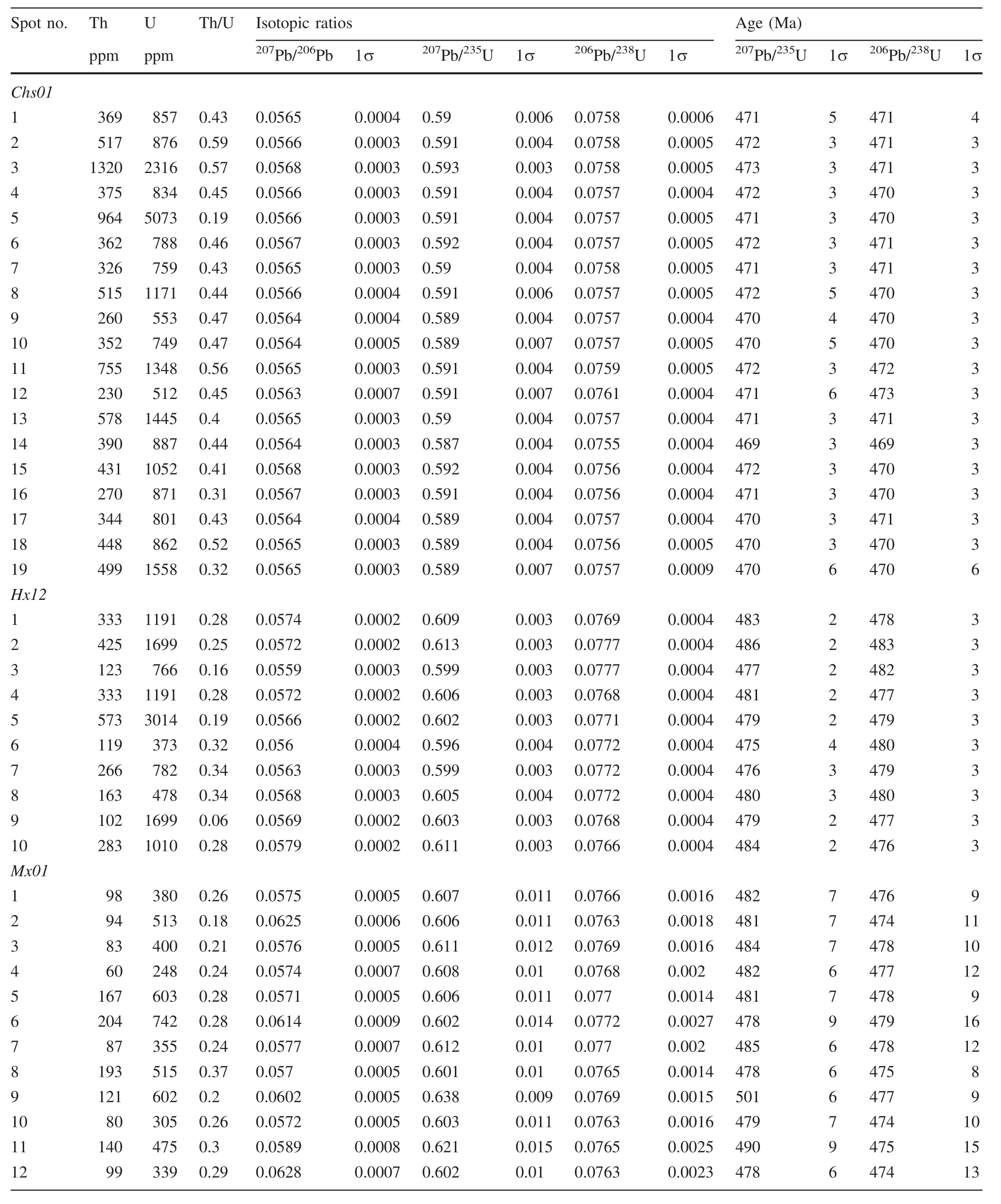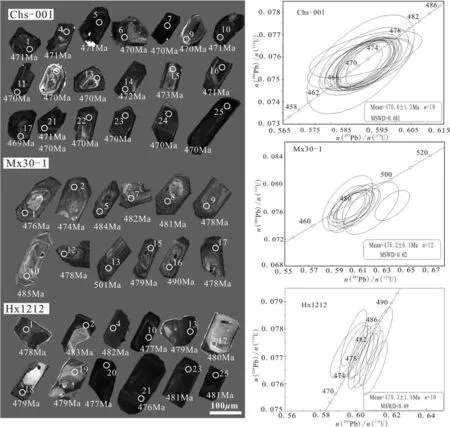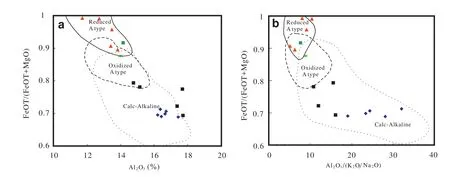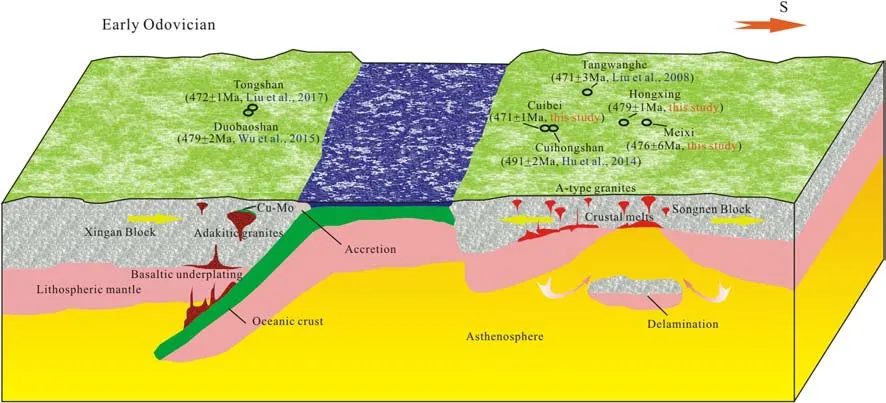Age and geochemistry of Early Ordovician A-type granites in the Northeastern Songnen Block,NE China
2018-10-25ChangzhouDengDeyouSunGuangyiSunChangluLvZhenQinXianquanPingGuanghuiLi
Changzhou Deng·Deyou Sun·Guangyi Sun·Changlu Lv·Zhen Qin·Xianquan Ping·Guanghui Li
Abstract Early Ordovician A-type granites in the northeastern(NE)Songnen Block NE China were studied to better understand the geodynamic settings in this region.This research presents new zircon U–Pb ages and wholerock geochemical data for the Early Ordovician granites in the NE Songnen Block.Zircon U–Pb dating indicates that the granite in the Cuibei,Hongxing,and Meixi areas in the NE Songnen Block formed in the Early Ordovician with ages of 471–479 Ma.The granites show geochemical characteristics of high SiO2and K2O compositions and low FeOT,MgO,CaO,and P2O5compositions.They belong to a high K calc-alkaline series and display a weak peraluminous feature with A/CNK values of 0.98–1.14.The rocks have a ∑REE composition of 249.98–423.94 ppm,and are enriched in LREE with(La/Yb)Nvalues of 2.87–9.87,and display obvious Eu anomalies(δEu=0.01–0.29).Trace elements of the studied granites are characterized by enrichment in Rb,Th,U,Pb,Hf,and Sm,and depletion of Ba,Nb,Ta,and Sr.They display geochemical features of high Zr+Y+Nb+Ce values(324–795 ppm)and Ga/Al ratios consistent with A-type granites.Based on particular geochemical features,such as high Rb/Nb(7.98–24.19)and Y/Nb(1.07–3.43),the studied A-type granites can be further classi fi ed as an A2-type subgroup.This research indicates that the Early Ordovician A-type granites were formed by the partial melting of ancient crust in an extensional setting.Lower Sr/Y and(Ho/Yb)Nratios indicate that plagioclase and amphibole are residual in the source,and garnet is absent,implying that the magma was generated at low levels of pressure.By contrast,the contemporaneous granites in the SE Xing’an Block suggest a subduction-related tectonic setting,and its adakitic property indicates a thickened continental crust.We suggest that the Paleo-Asian Ocean plate between the Xing’an and Songnen blocks subducted northward during the Early Ordovician.Meanwhile,the NE Songnen Block was exposed to a passive continental margin tectonic setting.
Keywords Early Ordovician·A-type granite·Songnen and Xing’an blocks ·Geodynamic setting
1 Introduction
The northeastern(NE)portion of the Songnen Block underwent complex tectonic evolution processes in the Phanerozoic Era,including the fi nal closure of the Paleo-Asian and Mongol-Okhotsk Oceans and the westward subduction of the Paleo-Paci fi c Ocean(Chen et al.2009;Ge et al.2005;Li 2006;Sengor and Natalin 1996;Wang and Mo 1995;Xu et al.1994).The complicated geological history has triggered extensive magmatism in this region,resulting in the widespread distribution of igneous rocks in the NE Songnen Block(Wu et al.2011;Xu et al.2013).The widely exposed igneous rocks provide a tool to reconstruct the tectonic evolution processes in the NE Songnen Block and adjacent area(e.g.,Hu et al.2014;Wang et al.2017;Wu et al.2015).Compared with the relatively well-understood Mesozoic geodynamic setting,the Paleozoic tectonic setting in the NE Songnen Block remains unclear.The subduction ward and chronology of the Paleo-Asian Oceanic slab between the NE Songnen Block and SE Xing’an Block are still indistinct.Wu et al.(2015)suggested that the northwestward subduction(under the Xing’an Block)of the ocean plate between the Songnen and Xing’an blocks occurred during the Late Ordovician.Zeng et al.(2014)argued that the northwestward subduction occurred at least in the Early Ordovician.Hu et al.(2014)suggested that the~491 Ma alkali-feldspar granites formed after the fi nal collision between the Xing’an and Songnen blocks.However,some studies indicated that the amalgamation between the two blocks occurred during the Late Carboniferous(Cui et al.2013;She et al.2012).Although some new geochronological and geochemical data from Early Paleozoic granites have been published in recent years(Chen et al.2014;Hu et al.2014;Wang et al.2016,2017),the geodynamic conditions related to the formation of these granites in the NE Songnen Block are not well-reconstructed.Chen et al.(2014)studied the~496 Ma granites in the Cuihongshan area and proposed that the crust growth of the Songnen Block mainly occurred in the Meso-Neoproterozoic,but the geodynamic conditions under which the~496 Ma granites were formed were not discussed.Wang et al.(2016,2017)reported on the Early Paleozoic igneous rocks in the eastern Songnen Block and discussed the collision process between the Songnen and Jiamusi blocks.The tectonic dynamics that in fl uenced the Songnen and Xing’an blocks were not reported.
In recent years,Early Ordovician granites were discovered in the Cuibei,Meixi,and Hongxing areas in the NE Songnen Block.These rocks generally showed geochemical characteristics of A-type granites.The Ordovician granites reported by Liu et al.(2008a,b)and Hu et al.(2014)in the Tangwanghe and Cuihongshan areas(Fig.1)also display features of A-type granite.Collectively,these granites support the need to decipher the Early Ordovician tectonic evolution and geodynamic conditions in this region.In this study,we examined the geochronological and geochemical data from the Early Ordovician granites in the NE Songnen Block and adjacent area,with the aims of constraining the petrogenesis of the Early Ordovician granites,discussing the geodynamic conditions in the NE Songnen Block,and identifying the subduction state of the Paleo-Asian Ocean between the NE Songnen Block and SE Xing’an Block.
2 Geology setting
The NE Songnen Block is located in the eastern part of the Central Asian Orogenic Belt,bordering the Xing’an Block to the northwest,and the Jiamusi Block to the southeast(Fig.1).The Paleozoic strata are sporadically distributed in the Mesozoic igneous rocks.They are mainly composed of volcanic,clastic,and carbonate rocks formed during Cambrian,Ordovician,and Permian periods(HBGMR 1993;Shao et al.2012).The Paleozoic carbonate rocks have a close af fi nity with metallization(Yang et al.2012),especially skarn-type Pb–Zn polymetallic deposits(Hu et al.2014).The Mesozoic strata are dominated by volcanic rocks,which mainly consist of basalt,trachyandesite,andesite,and rhyolite(Xu et al.2013).The volcanic rocks host several large-scale epithermal deposits,including Dongan and Gaosongshan Au deposits(Zhi et al.2016;Hao et al.2016).The Cenozoic strata are mainly composed of unconsolidated sediments in the northwestern part of the study area.The intrusive rocks are mainly Jurassic-Cretaceous granites,with minor Cambrian,Early Ordovician,and Late Permian-Early Triassic granites(Liu et al.2008a,b).According to Wu et al.(2000,2011),the widely distributed Jurassic-Early Cretaceous granites are I-and A-type granites,generally found in the form of batholiths and stocks.
The Early Ordovician granites examined are located in the Cuibei,Meixi,and Hongxing areas(Fig.1b)and mostly consist of alkaline-feldspar granite and minor granite porphyry.The fi eld outcrops of the granites show gray on weathered surfaces and fl esh red or gray on freshly exposed surfaces.Alkaline-feldspar granites from the Cuibei and Hongxing areas are composed primarily of medium- fi ne grain texture(Fig.2a,b),with a small amount of fi ne-grain texture(Fig.2c,d).The granites contain essential minerals of quartz(25–30 vol.%,1–3 mm),K-feldspar(50–55 vol.%,1–5 mm),biotite(5–15 vol.%,1–3 mm),and plagioclase(3–5 vol.% 1–3 mm),with minor accessory minerals,such as titanite,zircon,sericite,and apatite.Alkaline-feldspar granite from the Meixi area has a medium to coarse-grained granitic texture and massive structure(Fig.2e,f).The main minerals are quartz(20–25 vol.%),K-feldspar (40–45 vol.%),plagioclase(20–25 vol.%),biotite(5–10 vol.%),and a few accessory minerals(2–5 vol.%),such as magnetite,zircon,and apatite.The quartz grains are generally xenomorphic to subhedral with a grain size of 2–6 mm.The plagioclases occur as euhedral to subhedral granular aggregates 3–8 mm in size and develop polysynthetic twin and ribbon structures.K-feldspars are mainly euhedral to subhedral granular aggregates 3–8 mm in size.The granites show minor alterations,with feldspars locally showing sericitization and argilation,and biotite locally showing chloritization.

Fig.1 a Geological sketch map of NE China(modi fi ed from Wu et al.2007)and b simpli fi ed geological map of NE Songnen block
3 Analytical methods
We selected fi ve granites for a whole-rock geochemical study,and samples Chs-001,Hx12,and Mx01 were used for zircon U–Pb dating analysis.
Whole-rock major and trace elements were analyzed at the Hebei Institute of Regional Geological Survey and Research.Major elements were analyzed by X-ray fl uorescence.The analytical uncertainty associated with this method is generally<5%.The detailed analytical procedures follow Norrish and Hutton(1969).Trace element concentrations were determined using a Thermo-Finnigan element inductively coupled plasma mass spectrometer(ICP-MS)after HNO3–HF digestion of approximately 50 mg of the sample powder in a Te fl on vessel at 190°C.Analytical accuracy and precision were monitored by Chinese national reference GSR1(granite),and the detailed analytical procedures were described by Qi et al.(2000).The precision is 5%of the quoted values for elements present in quantities of less than 1 ppm.Accuracy is estimated to be better than 5%for the reported values.
Zircon grains were separated using conventional magnetic and density techniques,hand-picked under a binocular microscope,mounted in a 1-inch diameter epoxy resin,and polished to expose the centers of zircon grains.Prior to analytical work,all zircon grains were examined under a microscope with transmitted and re fl ected light and cathodoluminescene(CL)images were taken using a scanning electron microscope at Beijing Geoanalysis Co.,Ltd.to reveal their internal structures.LA–ICP–MS zircon U–Pb dating and trace elemental data were analyzed at the Tianjing Geological Survey Center’s isotope laboratory.Preferred U–Th–Pb isotopic ratios used for Zircon 91,500 geochemical microanalysis are from Wiedenbeck et al.(1995).Testing conditions and data processing procedures are similar to those described by Liu et al.(2010).Uncertainty of reference values for the external standard weighted mean calculation was examined using Isoplot/Ex_ver3(Ludwig 2003).Zircon U–Pb isotopic data from the granites are listed in Table 1.

Fig.2 Representative photographs and photomicrographs of Early Ordovician granites in the NE Songnen Block.a,b medium- fi ne grain Alkalifeldspar granite,c,d fi ne grain Alkali-feldspar granite,e,f coarse grain Alkali-feldspar granite.Af alkali-feldspar,Bi biotite,Q quartz,Pl plagioclase

Table 1 LA–ICP–MS zircon U–Pb dating for the granite samples in the NE Songnen Block
4 Results
4.1 Zircon U–Pb ages
The CL images of representative zircons are shown in Fig.3a.The results of LA-ICP-MS U–Pb isotopic analyses are presented in Fig.3b.Zircons from the studied samples were mostly yellow to colorless,euhedral,and long to short prismatic or fragment forms(Fig.3a).The crystals ranged in length from 70 to 300 μm,with length/width ratios from 2:1 to 3:1.Most zircons showed obvious oscillatory zoning(Fig.3a).Zircon grains from sample CHS01,Hx12,and Mx01 had variable U contents of 512–5073,373–3014 and 305–742 ppm,respectively.Most of the zircons(35 of 41)had relatively high Th/U ratios(>0.2),indicating a magmatic origin(Kinny et al.1990;Corfu et al.2003).
The weighted mean206Pb/238U ages for studied granite samples from the NE Songnen Block were 470.6±1.3 Ma(CHS01,n=19,MSWD=0.08),479±1.6 Ma(Hx12,n=10,MSWD=0.71),and476.2±6.1 Ma(Mx01,n=12,MSWD=0.03)(Fig.3b).The U–Pb ages indicate that the studied granites intruded in the Early Ordovician with ages of 471–479 Ma.

Fig.3 Zircon U–Pb Concordia diagrams for the samples and representative cathodoluminescence(CL)images of dated zircon crystals from granites in the NE Songnen block

Table 2 Major element(wt.%)and trace element(ppm)for A-type granites from NE Songnen Block

Fig.4 a SiO2versus K2O diagram(Peccerillo and Taylor 1976),b A/NK versus A/CNK diagram(after Maniar and Piccoli 1989).A/NK=Al/(Na+K)(molar ratio).A/CNK=Al/(Ca+Na+K)(molar ratio).Data of the Tongshan intrusion from Liu et al.(2017),Duobaoshan intrusion from Wu et al.(2015)
4.2 Whole rock major and trace element composition
Table 2 presents the whole-rock major and trace element compositions for fi ve granite samples in this study and four granite samples reported by Liu et al.(2008a,b)and Hu et al.(2014).The major elements of the studied granite samples showed high SiO2contents(70.52–77.85%),with an average value of 73.9%.K2O values were 4.37–6.21%,and Na2O composition was 2.33–3.56%;the combination of these values yielded a K2O/Na2O composition of 1.22–2.67.These values are characteristic of K-rich granite(Barbarin 1999),and are plotted in the shoshonitic fi eld in the K2O versus SiO2diagram(Fig.4a).Sampled rocks were observed to have 11.72–13.82%Al2O3content and A/CNK values of 0.98–1.14,belonging to a weak peraluminous granite(Fig.4b).Samples displayed relatively low Fe2O3T,MgO and CaO contents,with valuesof 1.27–3.85%,0.01–0.36%,and 0.34–1.73%,respectively.These rocks had low P2O5contents(0.013–0.063%),indicating a P de fi ciency.In Hark diagrams(Fig.5),Al2O3,CaO,MgO,P2O5,and TiO2show negative relationships with SiO2,whereas Na2O displays a positive relationship with SiO2.
The total composition of rare earth elements(REEs)in the granites ranges from 249.98 to 423.94 ppm,which is characterized by obvious LREE/HREE fractionation[(La/Yb)N=2.7–9.27]and clear negative Eu anomalies(Eu/Eu*=0.01–0.29)in the chondrite-normalized REE distribution patterns(Fig.6a).The primitive-mantle-normalized trace element spider diagram(Fig.6b)displays that the studied granites are relatively depleted in Ba,Sr and Zr.On the other hand,samples are relatively enriched in Th,U,Rb and Pb.Low Ba,Sr and strong negative Eu anomalies might suggest fractional crystallization of plagioclase.The depletion in P indicates that the magma underwent fractional crystallization of apatite and titanite.
5 Discussion
5.1 Petrogenesis and nature of the magma source
In general,the studied granites mainly consist of quartz,K-feldspar,biotite,and minor plagioclase.The high proportions of quartz and K-feldspar indicate the felsic and alkaline features of the rocks.Geochemically,the granites are characterized by higher Na2O+K2O,Fe/Mg,Ga/Al,and HFSE values while exhibiting lower CaO,Sr,and Eu contents than typical I-type granites(Bonin 2007;King et al.1997).The studied granites,together with the A-type granites reported by Liu et al.(2008a,b)and Hu et al.(2014),share similar geochemical characteristics:they have high K2O/Na2O ratios(1.2–2.7),high K2O contents(4.37–6.21%),and enrichments in REE(except Eu).The extremely low P2O5composition(0.01–0.07%),combined with the lack of muscovite and other Al rich minerals,suggest that the studied granites are not S-type granite(Bonin 2007;King et al.1997).In the 10,000*Ga/Al versus(K2O+Na2O)/CaO,Y,FeOT/MgO,and Nb diagrams,all of these granites fall into the category of A-type granites(Fig.7).Furthermore,the alkali-feldspar granites contain high total alkalis(K2O+Na2O=7.93–9%).The A/CNK(0.98–1.14)is higher than those of typical I-type granites,showing a peraluminous signature(Fig.4b).Their trace element characteristics are consistent with A-type granites,e.g.,enrichment in REEs and Ga and depletion in Eu.In the A1–A2 discrimination diagrams,the studied granites show an A2-type af fi nity(Fig.8),which belongs to post-orogenic granites(Eby 1992).Calculated zircon saturation temperatures of the studied granites are in the range of 800–934 °C with an average of 830 °C using the equation described by Watson and Harrison(1983).The studied rocks had high FeOT/(FeOT+MgO)values(0.88–0.99),belonging to reduced A-type granites(Fig.9),which have a relatively low oxygen fugacity and a relatively high partial melting temperature(Dall’Agnol and de Oliveira 2007).

Fig.5 Plots of selected major elements versus SiO2for the Early Ordovician granites in the NE Songnen Block.Symbols are the same as Fig.4

Fig.6 a Chondrite-normalized REE patterns.b Primitive mantlenormalized spider diagram for the granite.Chondrite and primitive mantle data are taken from Sun and McDonough(1989);symbols are the same as Fig.4
Three main scenarios have been proposed to account for the genesis of A-type granites,including lower crust(Turner et al.1992),upper mantle(Huang et al.2011)or combined mantle and crustal origins(Kemp et al.2005).The Early Ordovician A-type granites in the NE Songnen Block had a relatively narrow range of SiO2(70.52–77.85%)and low Co (0.8–2.1 ppm)and Ni(1.1–4.54 ppm)compositions.Early Ordovician A-type granites reported in previous studies performed within the study area exhibited negative zircon εHf(t)values(Hu et al.2014;Chen et al.2014).Combined with the lack of contemporary basic igneous rocks and ma fi c microgranular enclaves,the possibility of direct crystallization differentiation from mantle-derived magma or mantle-crustal magma mixing can be eliminated.The contemporaneous A-type granites in the Cuihongshan and Meixi area(Fig.1b)had negative zircon εHf(t)values ranging from-4.7 to 0 and-1.83 to-0.43 and show TDM2ages from 1414 to 1764 Ma and 1471 to 1560 Ma(Hu et al.2014;Chen et al.2014),respectively.These results indicate that the A-type granites in the NE Songnen Block were derived from an ancient crustal source.Magma derived from crust with residual garnet shows geochemical characteristics of(Ho/Yb)N>1.2 and Y/Yb>10(Ge et al.2002),whereas hornblende in the residual display fl at HREE patterns with Y/Yb≈10,(Ho/Yb)N≈1(Ge et al.2002;Hu et al.2012).The studied Early Ordovician granites had Y/Yb and(Ho/Yb)Nratios of 6.1–9.7 and 0.74–1.06,respectively.This indicates that amphibole is residual in the source and garnet is absent.
Previous research showed that Sr has a high af fi nity for plagioclase at lower pressures(<~10 kba;Kay and Mpodozis 2002)and tends to enter the melting phase as an incompatible element at higher pressures(>12 kba).In contrast,Y is inclined to enter garnet and amphibole at higher pressure and shows incompatible features under lower pressures(Lee et al.2007).Thus,Sr/Y ratios could indicate the mean pressure or depth in which the melts were generated(Chapman et al.2015).As discussed above,the studied granites display relatively low Sr(<175 ppm)and high Y(39.94–58.82 ppm),with lower Sr/Y ratios(0.36–2.50),suggesting that the melts generated at low pressures(<10 kba).The extremely negative Eu anomalies indicate the fractional crystallization of plagioclase and furtherimply thatthe meltsgenerated ata pressure<10 kba where plagioclase is stable.
The major elements versus SiO2diagrams(Fig.5)show linear trends for the major oxides,further indicating that magma was fractionated,to some degree,during their evolution.As previously mentioned,hornblende is considered to be an important phase fractionated from the granitic magmas because of their fairly fl at-HREE pattern and low MgO content.The depletion of Eu,Sr,and Ba indicates the fractional crystallization of feldspar.P2O5content decreased with increasing SiO2(Fig.5e),showing apatite fractionation.A negative Ti anomaly is commonly related to ilmenite or titanite fractionation.As a result,we can conclude that the crystal fractionation of feldspar,hornblende,Ti oxides,and apatite may be the main cause of the chemical variations between the studied granites.
5.2 Geodynamic setting
The geodynamic conditions that in fl uenced the NE Songnen Block during the Early Ordovician is debated(e.g.,whether the Paleo-Asian Ocean between the Xing’an and Songnen blocks began to subduct in the Early Ordovician,as well as the subduction direction).Studies of Early Ordovician granites in the southeast(SE)Xing’an Block(Wu et al.2015;Zeng et al.2014)propose different perspectives.Zeng et al.(2014)suggest that the Paleo-Ocean displayed bilateral subduction during the Early Ordovician.On the other hand,Wu et al.(2015)argued that the unidirectional northwestward subduction occurred in the Late Ordovician.Thedifferencesin geochemicalfeatures between the studied granites in the NE Songnen Block and the contemporaneous subduction-related granites in the SE Xing’an blocks give new insight into the geodynamic conditions in the studied and adjacent areas.

Fig.7 Discrimination diagrams for A-type granites(after Whalen 1987;Frost et al.2001).I-type granite:igneous protolith granite;S-type granite:sedimentary protolith granite.Symbols are the same as Fig.4
At present,researchers have reached a consensus that the A-type granite generated in an extensional tectonic environment under relatively low pressure(Anderson and Bender 1989).The studied granites indicate that there was a thinned crust in the NE Songnen Block in the Early Ordovician.By contrast,the synchronous granites with geochemical features of adakites from the SE Xing’an Block were derived from thicker lower crust(Liu et al.2017;Wu et al.2015).In addition,the Early Ordovician granites in the SE Xing’an Block triggered the mineralization and generated porphyry Cu–Mo deposits,which were generally considered to be formed in the subduction system and compressional tectonic setting(Sillitoe 2010).Thus,it is reasonable that the Paleo-Ocean between the Songnen and Xing’an blocks occurred as a northwestward subduction under the Xing’an Block in the Early Ordovician.Moreover,as proposed by Wu et al.(2015),the NE Songnen Block has experienced tectonic conditions consistent with a passive continental margin(Fig.10).
In recent years,regional geological surveys of varying scale were performed in the NE Songnen Block.Wang et al.(2016,2017)systematically studied the Early Paleozoic igneous rocks in the Songnen Block.This research reported no Early Ordovician adakitic igneous rock in this area,further indicating that NE Songnen and SE Xing’an blocks were exposed to different tectonic conditions in the Early Ordovician.Although some Early Paleozoic calcalkali granites were discovered in the NE Songnen Block,Wang et al.(2016,2017)suggested that their presence is the result of a northwestward subduction of the Paleo-Ocean between the Songnen and Jiamusi blocks.
Geochemical features of the A2 sub-type granites indicate an orogenic event before the generation of the A-type granites,which supports results reported by Liu et al.(2008a,b).According to Wang et al.(2017),the Early-Mid Cambrian collision between the northern Songnen and northern Jiamusi blocks might be the mechanism of the orogenic event in the study area.Our results suggest that the Songnen and Xing’an blocks also underwent squeezing stresses before the Early Ordovician and led to the formation of a subduction system under the SE Xing’an Block(Fig.10).Results indicate that the northwestward subduction of the oceanic crust between the Songnen and Xing’an blocks started before the Early Ordovician and led to the partial melting of the young basaltic lower crust,forming the ore-causative granite in the SE Xing’an Block.The collision between the NE Songnen and north Jiamusi blocks formed in the orogeny in the NE Songnen Block(Wang et al.2017).The delamination and thinning of the lower crust In the Early Ordovician and the upwelling of the asthenosphere led to the partial melting of the ancient lower crust and formed the A-type granite in the NE Songnen Block.Thus,the A-type granites in the NE Songnen Block suggest that the post-orogenic extension began in the Early Ordovician at the latest.

Fig.8 The A1 and A2 subgroup discriminations of A-type granites in NE Songnen block(Eby 1992).Symbols are the same as Fig.4

Fig.9 Whole-rock diagrams for a FeOT/(FeOT+MgO)versus Al2O3and b FeOt/(FeOt+MgO)versus Al2O3/(K2O/Na2O),showing the compositional fi elds of reduced and oxidized A-type granites and calc-alkaline granites(Dall’Agnol and de Oliveira 2007).Symbols are the same as Fig.4

Fig.10 Simpli fi ed cartoon depicting the geodynamic scenario of the Early Ordovician granites in the NE Songnen Block and adjacent area
6 Conclusions
The following conclusions were developed based on our study of new zircon U–Pb age,whole rock geochemical data,and the compilation of the geochronology and geochemistry data of the Early Ordovician granites in the NE Songnen Block and adjacent area:
1. The zircon U–Pb data show that the studied granites in the NE Songnen Block were formed in the Early Ordovician(471–479 Ma).
2. The studied rocks showed geochemical characteristics of A-type granites and were derived from the partial melting of ancient lower crust at low pressure levels.
3. The A-type granite in the NE Songnen Block and the contemporaneous arc-related granite in the South Xing’an Block may indicate that the Paleo-Asian Ocean plate between the two blocks subducted northward in the Early Ordovician.
AcknowledgementsThis work was supported by the research program of Heilongjiang province (Nos. SDKC2017030 and HDKK201701).We especially thank three anonymous reviewers for their insightful and constructive comments.
Compliance with ethical standards
Con fl ict of interestAll authors declare that they have no con fl ict of interest.
杂志排行
Acta Geochimica的其它文章
- The effects of clay minerals and organic matter on nanoscale pores in Lower Paleozoic shale gas reservoirs,Guizhou,China
- Origin and genetic family of Huhehu oil in the Hailar Basin,northeast China
- Genesis of fahlore in the Tianbaoshan lead–zinc deposit,Sichuan Province,China:a scanning electron microscopy–energy dispersive spectroscopy study
- The morphological characteristics of gully systems and watersheds in Dry-Hot Valley,SW China
- State of rare earth elements in the rare earth deposits of Northwest Guizhou,China
- Does bicarbonate affect the nitrate utilization and photosynthesis of Orychophragmus violaceus?
